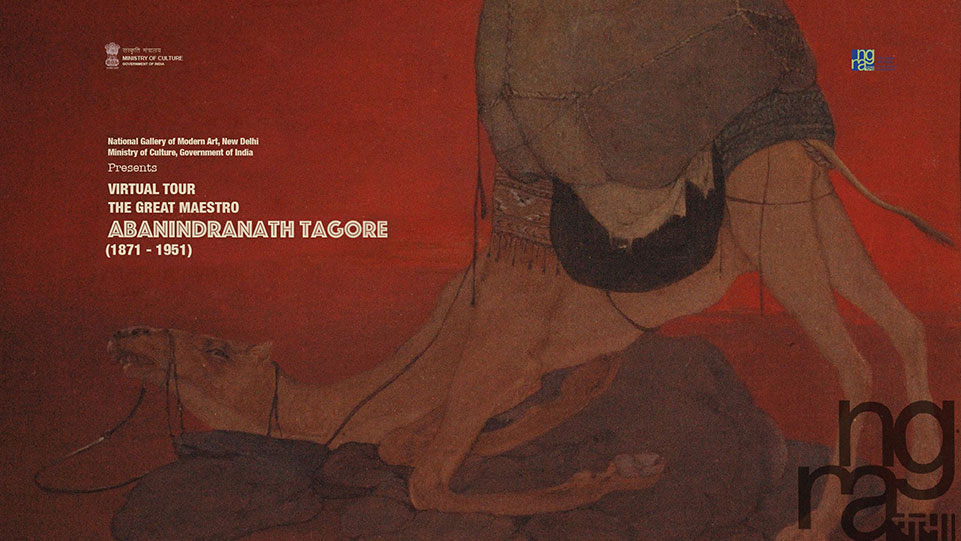-

-
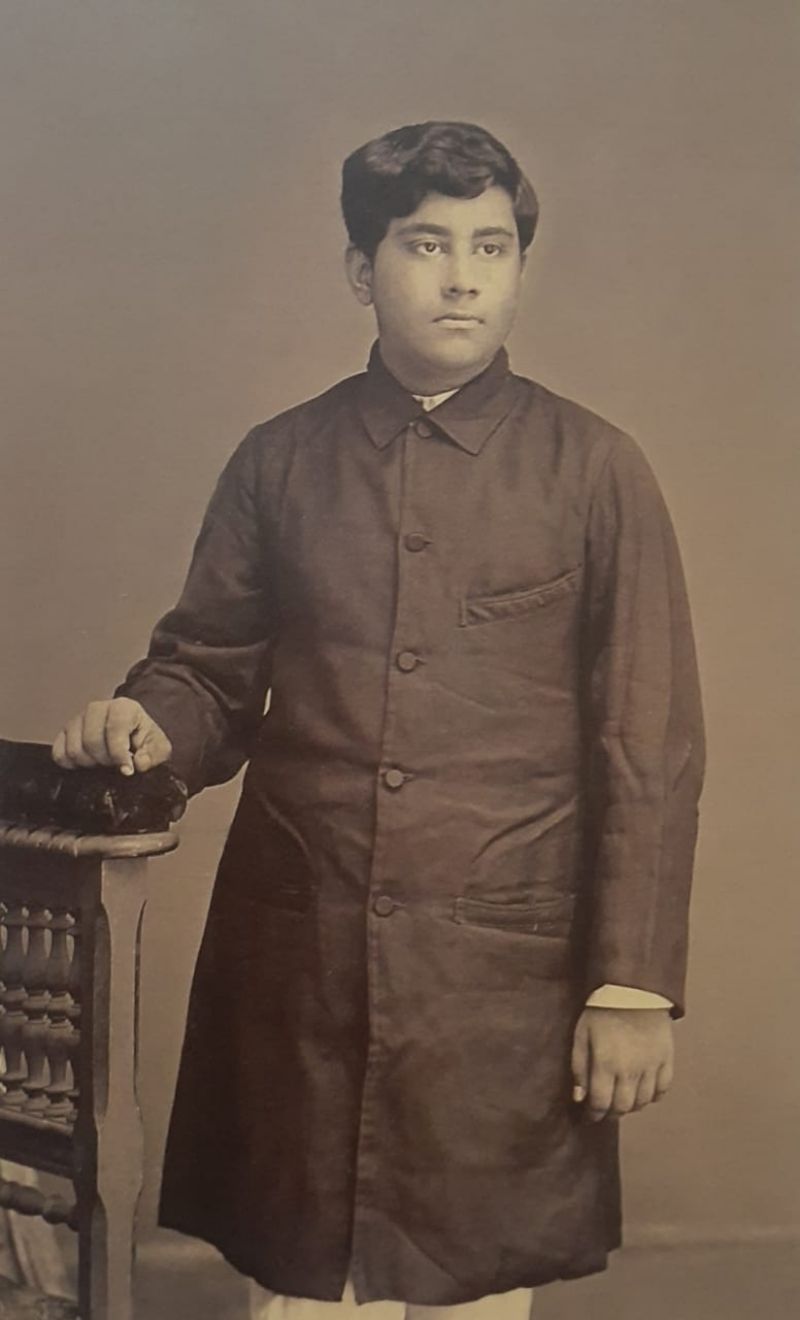
Abanindranath Tagore
-
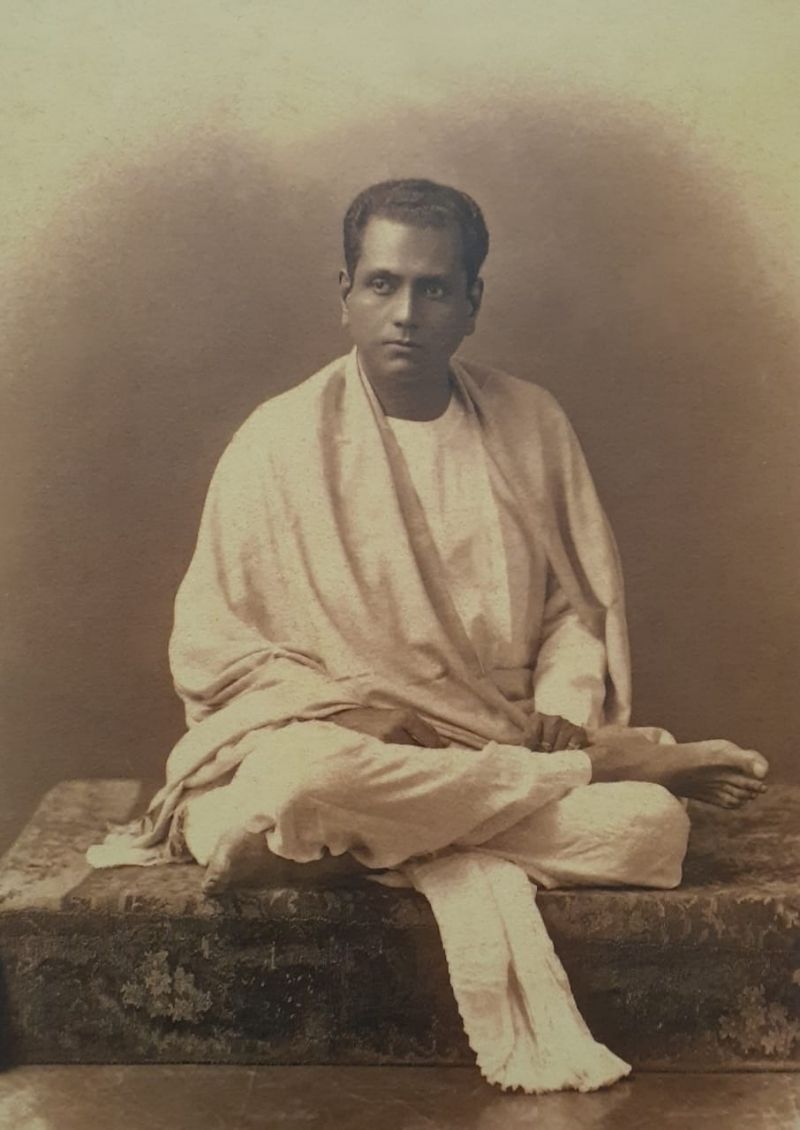
Abanindranath at the Art School
-
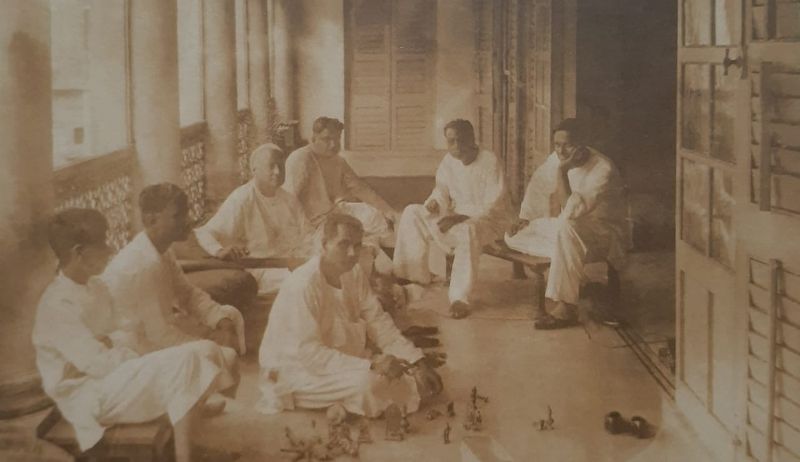
Abanindranath on the South Varandah with family members
-
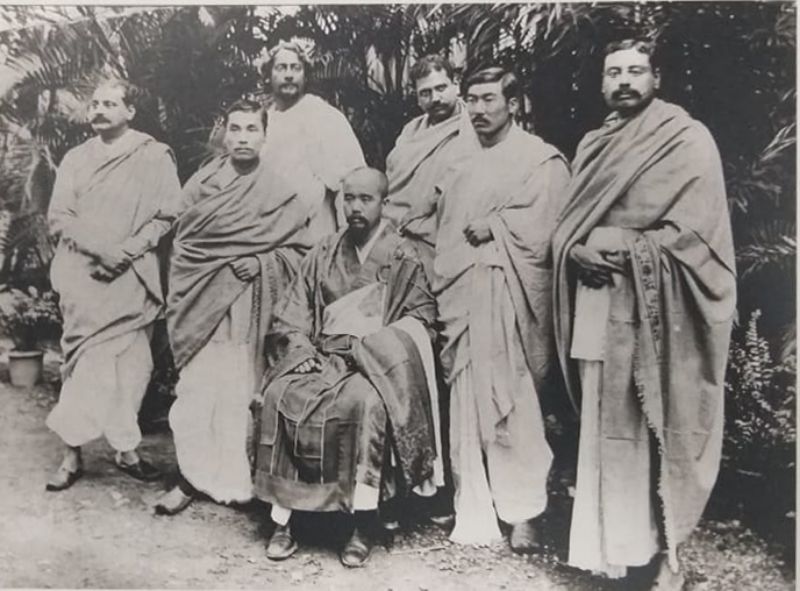
Jorasanko 1905 : (Standing R to L) Samarendranath, Sano, Abanindranath, Rabindranath, Katsuta, Gaganendranath (Seated) Kawaguchi
-

Abanindranath and Gaganendranath on the South Varandah
-
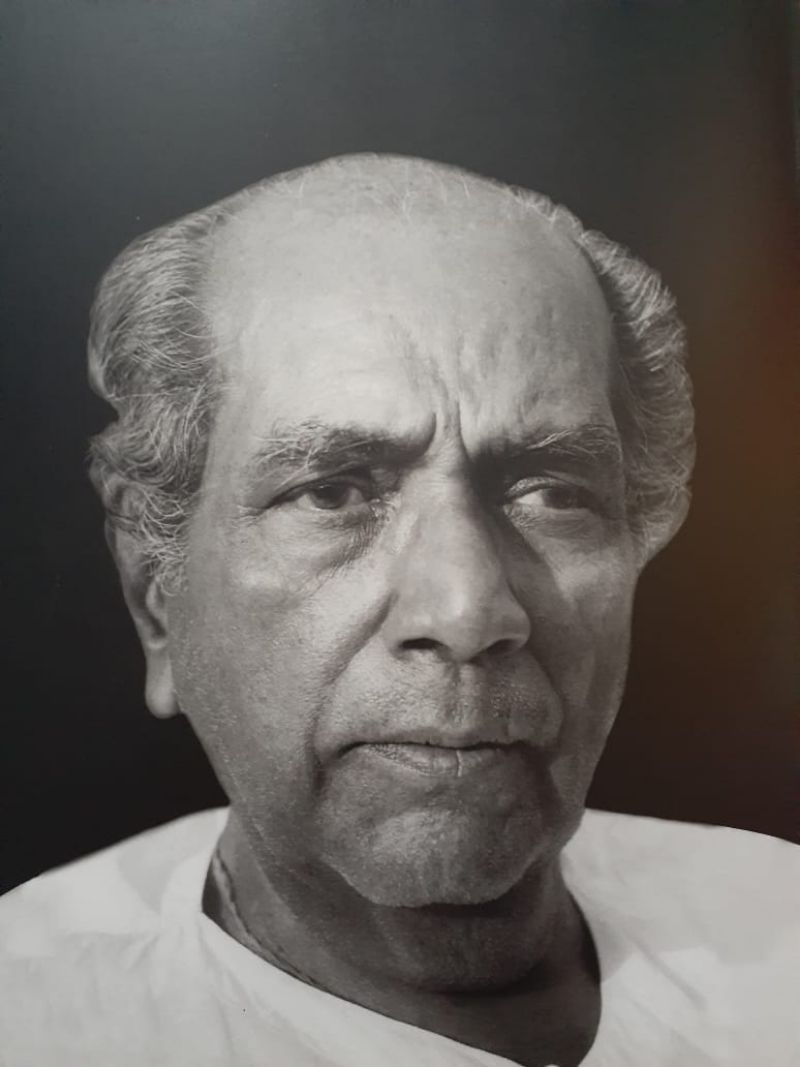
Abanindranath Tagore
-
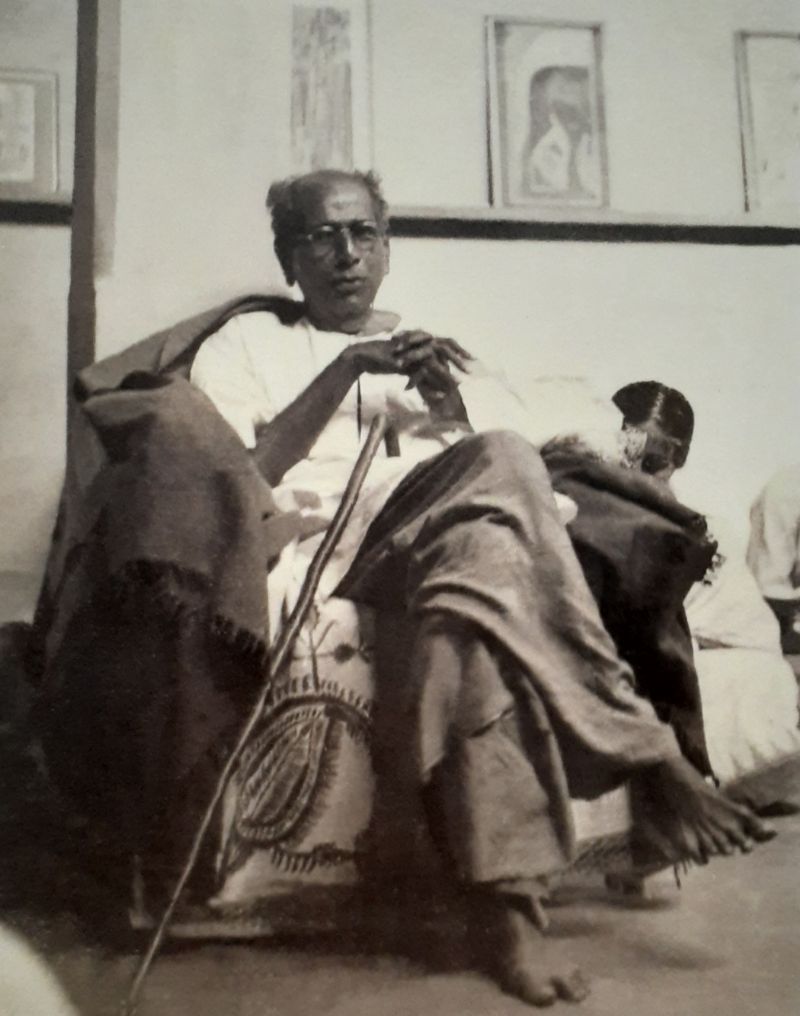
Abanindranat at Kala Bhavana
-

Abanindranat Tagore
-
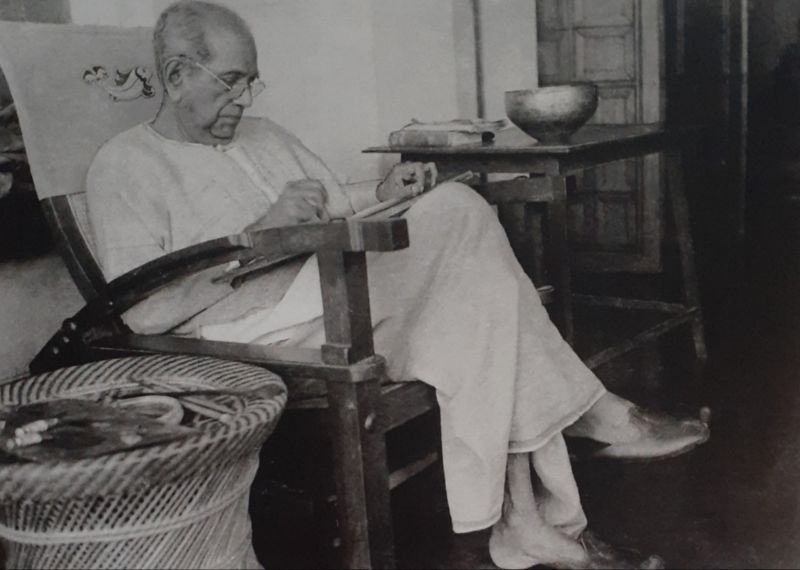
Abanindranath on the South Varandah : 1944
-
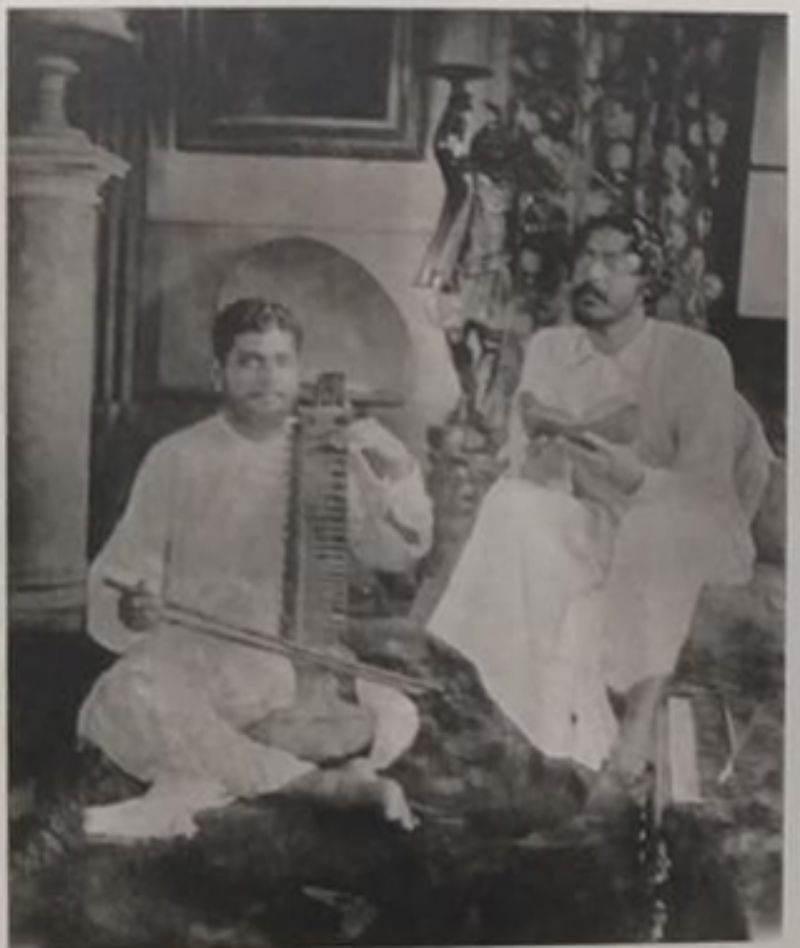
Jorasanko 1888 : Rabindranath Tagore singing to the accompaniment of 'Esraj' played by Abanindranath Tagore
-
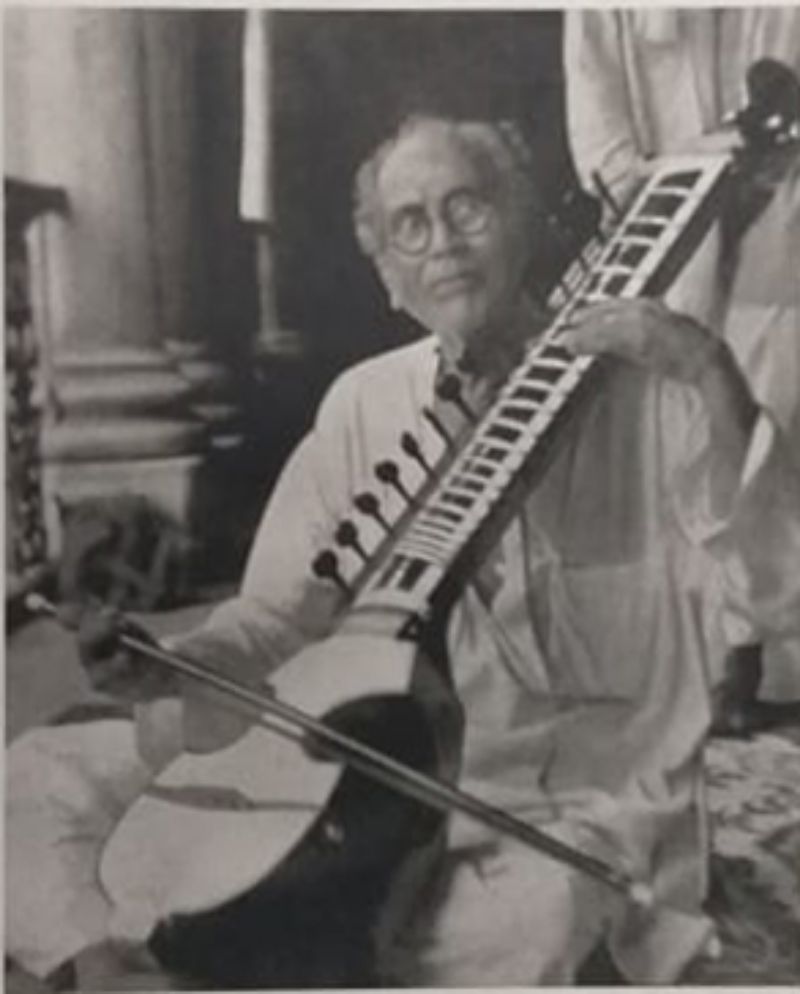
Abanindranath Tagore playing the 'Esraj'
-

Nandalal Bose with Abanindranath on his (later's) birthday
-
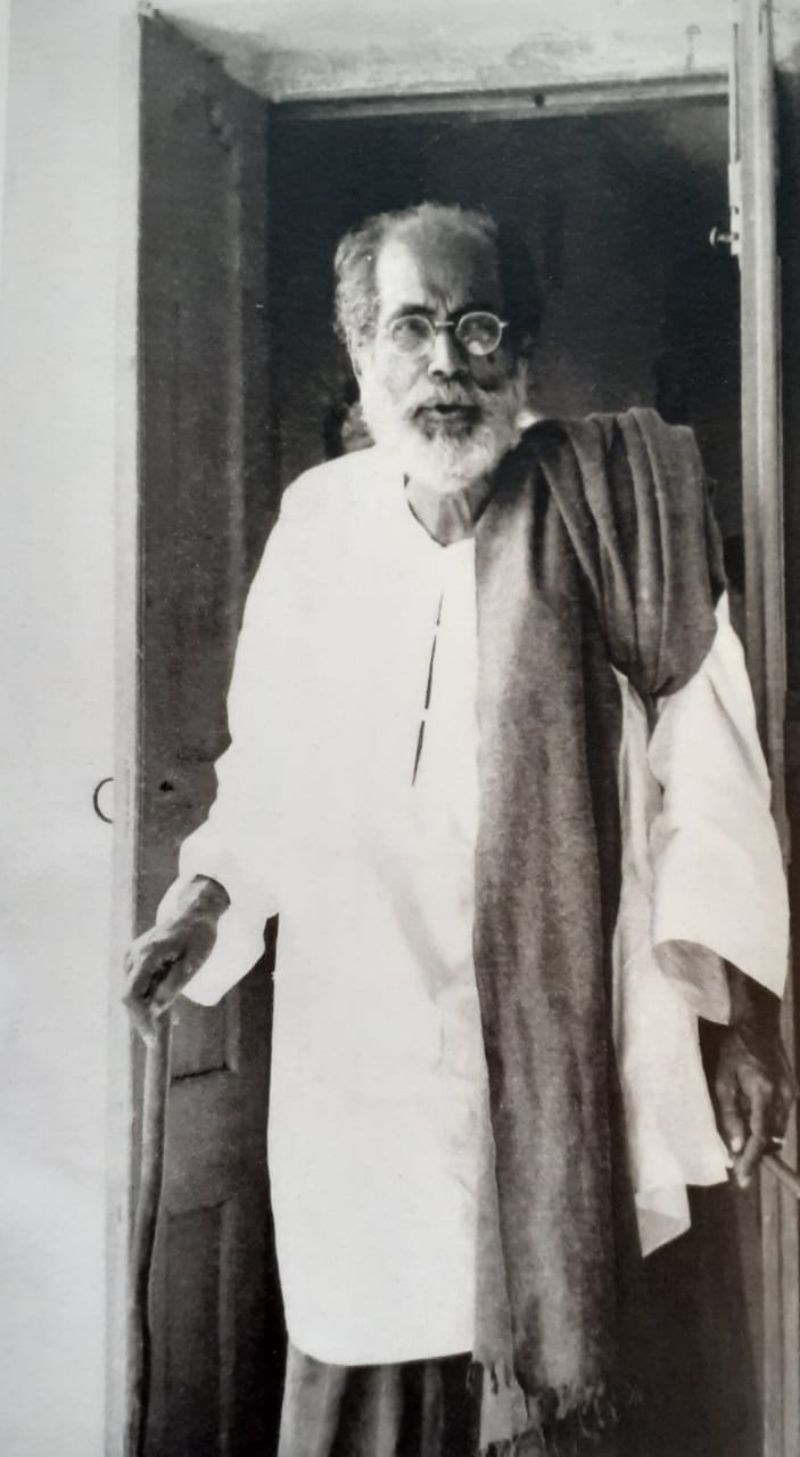
Abanindranath Tagore in the famous "Dakshiner Barandah"of Jorasanko House
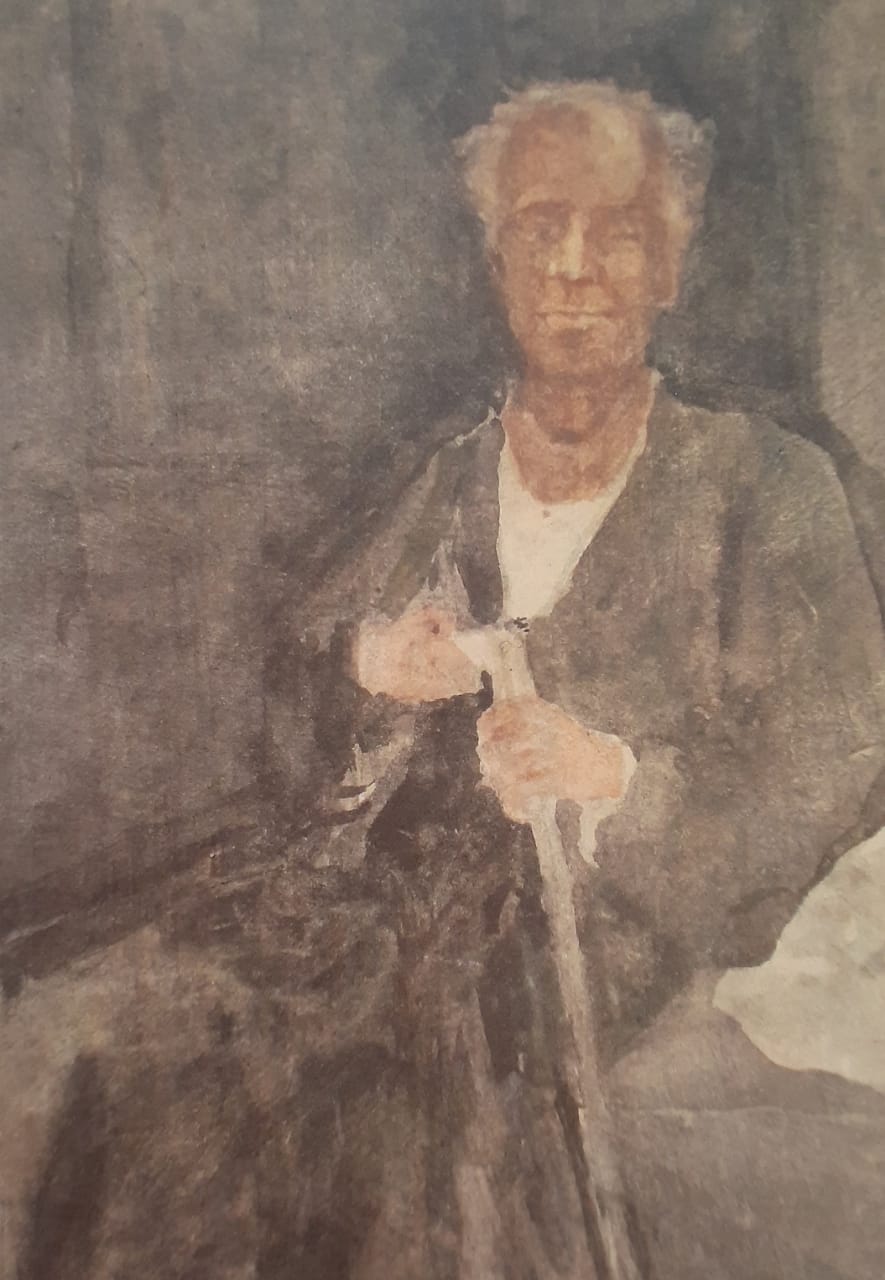
The Great Maestro - Abanindranath Tagore
(7.8.1871 - 5.12.1951)
A Tribute to The Great Maestro - Abanindranath Tagore on the eve of his 150th Birth Anniversary
Artist's Profile
Abanindranath Tagore was born in the creatively distinguished family of Tagores of Jorasanko in Kolkata. In his youth, Abanindranath received training in European and Academic style from European artists, Olinto Gilhardi and C.E.Palmer. But sometime during the last decade of the 19th century, he developed distaste for the corporeality of European naturalism. Coincidentally, about the same time he received an album of Mughal miniatures and a book of English poems illuminated in the Art Nouveau style. These influenced Abanindranath's visual ideas deeply. A third source of inspiration came from the visit of the Japanese philosopher and aesthetician Okakura Kakuzo to Kolkata in 1902. Okakura's visit led to the coming of the Japanese artists Taikan and Hishida in 1903. The two Japanese artists taught Abanindranath the wash technique which appealed to the artists' romanticism. These various triggers led Abanindranath to evolve a distinctive visual language that was delicate, sensitive, dreamy and rich in atmosphere he synthesized in his paintings the Western and Eastern aesthetics. Although, Abanindranath painted a range of subjects, he had a leaning towards painting images with historic or literary allusions. He liked to paint sets of images dealing with a theme or a text such as the 'Arabian Nights' or the 'Krishna Leela'. He also enjoyed painting theatrical subjects. Literature and drama held great respect for him and he was an elegant and accomplished writer. Towards his sunset years, he started making whimsical sculptures with found material like driftwood. The NGMA has a few of his these works.
Literary Reference:
1) Appasamy, Jaya. Abanindranth Tagore and the Art of his Times, New Delhi, Lalit Kala Akademi, 1968
2) Parimoo, Ratan, The Paintings of the Three Tagores, Baroda, MS University, 1973
3) Guha Thakurta, Tapati, The Making of a New Indian Art, Cambridge University Press, 1992
4) Mitter, Partha. Art and Nationalism in Colonial India, 1850 - 1922, Cambridge University Press, 1994
5) Siva, Kumar R. Paintings of Abanindranath Tagore, Kolkata, Pratikshan, n.d.

Research Material
Team JATAN, NGMA New Delhi
Concept, Design & Development
IT Cell, NGMA
Content Management
IT Cell
Title Image of Abanindranath Tagore
&
Resources for ‘Jeevansmriti’
Re-photographed from the book ‘Painting of Abanindranath Tagore by R Siva Kumar published by Pratikshan in association with Reliance Industries Limited.
-
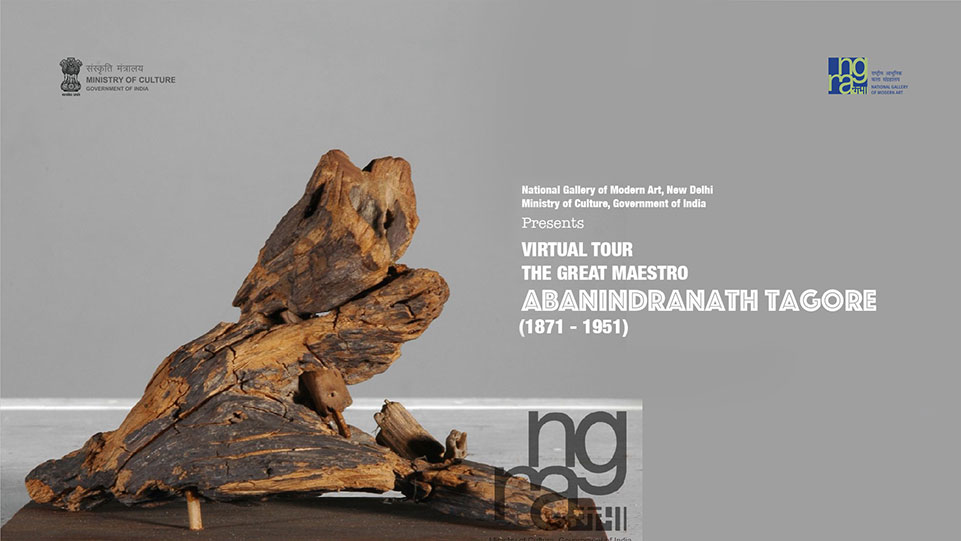
-
Painting
 ×According to artist Benodebehari Mukherjee, who compiled a rough chronology of Abanindranath's paintings, between 1915 and 1916, the artist painted a series of animal life images. In this above painting, he has depicted a calf tied up outside a hut, rendered with the soft shades of pastel colour delineating the form and adding grace to the composition.
×According to artist Benodebehari Mukherjee, who compiled a rough chronology of Abanindranath's paintings, between 1915 and 1916, the artist painted a series of animal life images. In this above painting, he has depicted a calf tied up outside a hut, rendered with the soft shades of pastel colour delineating the form and adding grace to the composition. -
Painting
 ×Leader of the Revivalist Movement in the field of Modern Indian Painting in Bengal, Abanindranath Tagore is also credited with a key contribution towards ushering in the renaissance in Indian painting.Abanindranath's inner urge for liberating Indian art was further inspired by Okakura, a great Japanese artist and art-critic who came to India with Swami Vivekananda. His work has a great delicacy of feeling, unity of concept, a highly sensitive range of color, tone, texture and poetic depth. His work was a mixture of traditionalism and innovation. He aimed at comparing nature in its transient forms and produce an image part object, part sensuous, both transposed into each other. But his vision on nature was always poetic, as was his personal form of expression. According to artist Benodebehari Mukherjee, who compiled a rough chronology of Abanindranath's paintings, the artist painted a series of animal life images between 1915 and 1916. This painting is done in clear, bright colours.
×Leader of the Revivalist Movement in the field of Modern Indian Painting in Bengal, Abanindranath Tagore is also credited with a key contribution towards ushering in the renaissance in Indian painting.Abanindranath's inner urge for liberating Indian art was further inspired by Okakura, a great Japanese artist and art-critic who came to India with Swami Vivekananda. His work has a great delicacy of feeling, unity of concept, a highly sensitive range of color, tone, texture and poetic depth. His work was a mixture of traditionalism and innovation. He aimed at comparing nature in its transient forms and produce an image part object, part sensuous, both transposed into each other. But his vision on nature was always poetic, as was his personal form of expression. According to artist Benodebehari Mukherjee, who compiled a rough chronology of Abanindranath's paintings, the artist painted a series of animal life images between 1915 and 1916. This painting is done in clear, bright colours. -
Painting
 ×In the early years of the twenties of the 20th century, Abanindranath painted once again a number of fictional portraits of Mughal emperors. This painting made c.1920 shows the Mughal emperor Jahangir travelling towards Kashmir.
×In the early years of the twenties of the 20th century, Abanindranath painted once again a number of fictional portraits of Mughal emperors. This painting made c.1920 shows the Mughal emperor Jahangir travelling towards Kashmir. -
Painting
 ×It would be difficult to deduce the period of this painting but the image of the animal against a rocky formation makes one infer that it could be between 1919 and 1920 when Abanindranath painted the Darjeeling series.
×It would be difficult to deduce the period of this painting but the image of the animal against a rocky formation makes one infer that it could be between 1919 and 1920 when Abanindranath painted the Darjeeling series. -
Painting
 ×This could have been painted between 1915 and 1916 when Abanindranath painted many animals and birds
×This could have been painted between 1915 and 1916 when Abanindranath painted many animals and birds -
Painting

Message of Spring Acc. No. 1167 | Wash and tempera
-
Painting
 ×From 1910 onwards, Abanindranath painted many studies of animal life. With his sensitive delineation he could brig out the essence of their beauty. He had made several paintings of peacocks.
×From 1910 onwards, Abanindranath painted many studies of animal life. With his sensitive delineation he could brig out the essence of their beauty. He had made several paintings of peacocks. -
Painting
 ×Throughout his life, Abanindranath paitned a great deal of animal life. He used a particularly dark palette in most of the paintings done between 1915-1916 and many animal studies were done in this period. It was quite customary to introduce a narrative element in his animal studies.
×Throughout his life, Abanindranath paitned a great deal of animal life. He used a particularly dark palette in most of the paintings done between 1915-1916 and many animal studies were done in this period. It was quite customary to introduce a narrative element in his animal studies. -
Painting
 ×Abanindranath painted several peacocks and as with all his animal studies, he has invested a narrative quality to this image as well. The peacock is a character in a particular setting that hints at a story built into it.
×Abanindranath painted several peacocks and as with all his animal studies, he has invested a narrative quality to this image as well. The peacock is a character in a particular setting that hints at a story built into it. -
Painting
 ×This monochromatic work with faint touches of red was executed with vivid calligraphic brushwork carries the artist's signature written vertically in Devanagari script on middle left of the painting.
×This monochromatic work with faint touches of red was executed with vivid calligraphic brushwork carries the artist's signature written vertically in Devanagari script on middle left of the painting. -
Painting
 ×This painting is very illustrative in character and is executed in a very innovative style. There is a strong narrative under-current in the painting. Around 1925, Abanindranath painted the 'Playmate' series of paintings as well as a number of animal and bird studies.
×This painting is very illustrative in character and is executed in a very innovative style. There is a strong narrative under-current in the painting. Around 1925, Abanindranath painted the 'Playmate' series of paintings as well as a number of animal and bird studies. -
Painting
 ×The peacock seems to have been a favourite subject for Abanindranath Tagore. This could have been done in the early phase of his paintings from 1915 onwards. He was using a darker toned palette at the time as can be seen in the yellows, browns, greys and greens in this image. The bird is fore grounded against a misty wooded landscape.
×The peacock seems to have been a favourite subject for Abanindranath Tagore. This could have been done in the early phase of his paintings from 1915 onwards. He was using a darker toned palette at the time as can be seen in the yellows, browns, greys and greens in this image. The bird is fore grounded against a misty wooded landscape. -
Painting

Journey's End Acc. No. 1832 | Tempera on paper
-
Painting
 ×Abanindranath endows this beautiful painting with a hint of narrative as if the animals are waiting to step into a story. There is a humanness and intimacy about them, often noticed in the artist's animal paintings. R Shiv Kumar dates this painting c. 1920's.
×Abanindranath endows this beautiful painting with a hint of narrative as if the animals are waiting to step into a story. There is a humanness and intimacy about them, often noticed in the artist's animal paintings. R Shiv Kumar dates this painting c. 1920's. -
Sculpture
 ×From 1940 onwards, Abanindranath Tagore made playful, whimsical, small-sized sculptural works with found objects like roots, branches, twigs and so on. Given the fanciful nature of the objects, in which he made minimum of intervention, he called them Kutum Katum.
×From 1940 onwards, Abanindranath Tagore made playful, whimsical, small-sized sculptural works with found objects like roots, branches, twigs and so on. Given the fanciful nature of the objects, in which he made minimum of intervention, he called them Kutum Katum. -
Sculpture
 ×From 1940 onwards, Abanindranath Tagore made playful, whimsical, small-sized sculptural works with found objects like roots, branches, twigs and so on. Given the fanciful nature of the objects, in which he made minimum of intervention, he called them Kutum Katum.
×From 1940 onwards, Abanindranath Tagore made playful, whimsical, small-sized sculptural works with found objects like roots, branches, twigs and so on. Given the fanciful nature of the objects, in which he made minimum of intervention, he called them Kutum Katum. -
Sculpture
 ×From 1940 onwards, Abanindranath Tagore made playful, whimsical, small-sized sculptural works with found objects like roots, branches, twigs and so on. Given the fanciful nature of the objects, in which he made minimum of intervention, he called them Kutum Katum.
×From 1940 onwards, Abanindranath Tagore made playful, whimsical, small-sized sculptural works with found objects like roots, branches, twigs and so on. Given the fanciful nature of the objects, in which he made minimum of intervention, he called them Kutum Katum. -
Sculpture
 ×From 1940 onwards, Abanindranath Tagore made playful, whimsical, small-sized sculptural works with found objects like roots, branches, twigs and so on. Given the fanciful nature of the objects, in which he made minimum of intervention, he called them Kutum Katum.
×From 1940 onwards, Abanindranath Tagore made playful, whimsical, small-sized sculptural works with found objects like roots, branches, twigs and so on. Given the fanciful nature of the objects, in which he made minimum of intervention, he called them Kutum Katum.
-

-
Painting
 ×Landscapes were a favourite genre for Abanindranath wherein he could invest the scene with a mood. This pastel painting reflects the mood of the 'Puri' series evoking the vast emptiness of space. The land, the water, the sky were depicted by horizontal bands of sensitive colour giving the picture space a sense of liberation.
×Landscapes were a favourite genre for Abanindranath wherein he could invest the scene with a mood. This pastel painting reflects the mood of the 'Puri' series evoking the vast emptiness of space. The land, the water, the sky were depicted by horizontal bands of sensitive colour giving the picture space a sense of liberation. -
Painting
 ×The treatment of this painting is reminiscent of the Puri series of landscapes begun around 1911 where an expanse of space is suggested by minimal intervention on the paper.
×The treatment of this painting is reminiscent of the Puri series of landscapes begun around 1911 where an expanse of space is suggested by minimal intervention on the paper. -
Painting

Peace Cottage Acc. No. 1178 | Watercolour on paper
-
Painting
 ×Abanindranath's painting of a bull highlights the story-telling aspect of the artist's imagination. Abanindranath's place as a master story teller of Bengali children's literature is well established. He endows his animals with almost human feelings and emotions. The solitary animal in the image is homesick for his distant mountain home. It has reference to the mythological account of the bull being the vehicle of Shiva whose abode is Mount Kailash. The palette indicates that the painting may have been done between 1915 and 1920.
×Abanindranath's painting of a bull highlights the story-telling aspect of the artist's imagination. Abanindranath's place as a master story teller of Bengali children's literature is well established. He endows his animals with almost human feelings and emotions. The solitary animal in the image is homesick for his distant mountain home. It has reference to the mythological account of the bull being the vehicle of Shiva whose abode is Mount Kailash. The palette indicates that the painting may have been done between 1915 and 1920. -
Painting
 ×Abanindranath Tagore visited Santiniketan for the second time in 1923. It was around this time that the Uttarayan building complex was beginning to take shape in a vertical orientation in the left hand corner of the painting. (See Andrew Robinson's article in Pratapaditya Pal ed. Something old, something new: Rabindranath Tagore 150th Birth Anniversary Volume' Marg, Vol. 62, No.3, 2011)
×Abanindranath Tagore visited Santiniketan for the second time in 1923. It was around this time that the Uttarayan building complex was beginning to take shape in a vertical orientation in the left hand corner of the painting. (See Andrew Robinson's article in Pratapaditya Pal ed. Something old, something new: Rabindranath Tagore 150th Birth Anniversary Volume' Marg, Vol. 62, No.3, 2011) -
Painting
 ×The painting like most of his landscapes succeeds in evoking a mood.
×The painting like most of his landscapes succeeds in evoking a mood. -
Painting

Sparrow Acc. No. 1203 | Wash and tempera on paper
-
Painting

Trees Acc. No. 4503 | Watercolour on paper
-
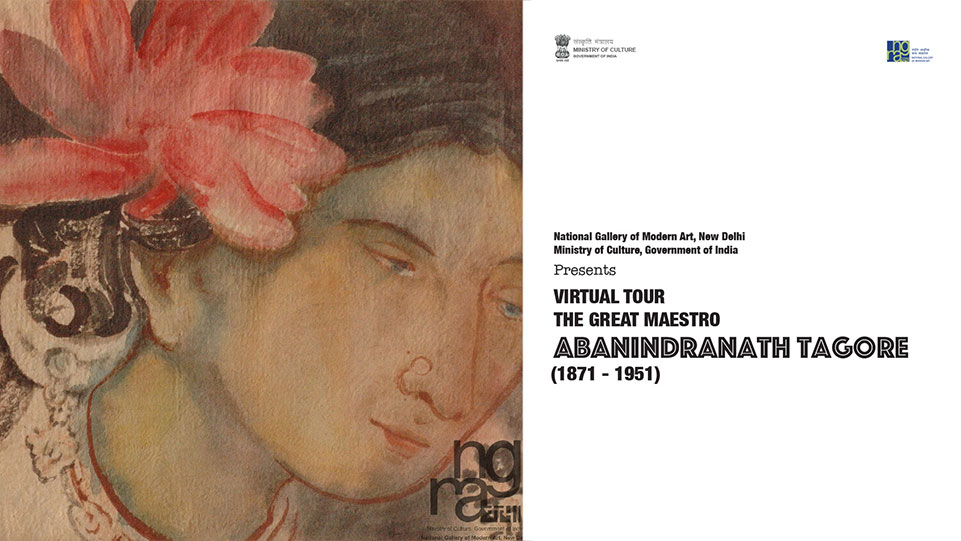
-
Painting
 ×From the manner in which this profile is executed, it appears to have been done in the last decade of the 19th century. Abanindranath at this time was training under European teachers Ghilardi and Palmer. Most of the works done at this time shows the influence of European techniques, such as in the application of light and shade. At this stage not much emphasis was given to facial expressions.
×From the manner in which this profile is executed, it appears to have been done in the last decade of the 19th century. Abanindranath at this time was training under European teachers Ghilardi and Palmer. Most of the works done at this time shows the influence of European techniques, such as in the application of light and shade. At this stage not much emphasis was given to facial expressions. -
Painting
 ×Between 1920 and 1925, Abanindranath Tagore made many portraits. From the details of features, it appears that the portrait could be of a hill girl. The flat cheek bones, the slanted eyes and drooping eyelids point to the fact that the portrait could be of a real person and not of an imagined character.
×Between 1920 and 1925, Abanindranath Tagore made many portraits. From the details of features, it appears that the portrait could be of a hill girl. The flat cheek bones, the slanted eyes and drooping eyelids point to the fact that the portrait could be of a real person and not of an imagined character. -
Painting
 ×Painting on both sides of paper. The recto of the painting is signed 'Abanindra' in Bengali at the top left corner of the painting in brush in a persian style script designed by the artist. The painting has an incription at the bottom center which reads 'Narangi Madhu' in Bengali which means 'Orange Honey'.
×Painting on both sides of paper. The recto of the painting is signed 'Abanindra' in Bengali at the top left corner of the painting in brush in a persian style script designed by the artist. The painting has an incription at the bottom center which reads 'Narangi Madhu' in Bengali which means 'Orange Honey'. -
Painting
 ×Painting on both sides of paper. The recto of the painting is signed 'Abanindra' in Bengali at thetop right corner of the painting in brush in a persian style script designed by the artist. The painting has an incription at the bottom center which reads 'Neel Madhu' in Bengali which means 'Blue Honey'.
×Painting on both sides of paper. The recto of the painting is signed 'Abanindra' in Bengali at thetop right corner of the painting in brush in a persian style script designed by the artist. The painting has an incription at the bottom center which reads 'Neel Madhu' in Bengali which means 'Blue Honey'. -
Painting
 ×Surangama was the character of a maid in Rabindranath Tagore's play 'Raja' written in 1910-11. It was staged soon after at the family stage at Jorasanko, Kolkata. Abanindranath's portrait is not the likeness of a real person, but the imagined depiction of a character in a play. It is possible that the painting could have been made at the same time when the play was screened.
×Surangama was the character of a maid in Rabindranath Tagore's play 'Raja' written in 1910-11. It was staged soon after at the family stage at Jorasanko, Kolkata. Abanindranath's portrait is not the likeness of a real person, but the imagined depiction of a character in a play. It is possible that the painting could have been made at the same time when the play was screened. -
Painting
 ×Abanindranath had devised an ingenious way to write in Bengali letters in Arabic style. The title of the painting 'Shwet Madhu' in Bengali written on the bottom border. Between 1910 and 1920, Abanindranath painted many Islamic characters from history. This miniature style portrait could well belong to that period.
×Abanindranath had devised an ingenious way to write in Bengali letters in Arabic style. The title of the painting 'Shwet Madhu' in Bengali written on the bottom border. Between 1910 and 1920, Abanindranath painted many Islamic characters from history. This miniature style portrait could well belong to that period. -
Painting
 ×Signed 'Abanindra' in Bengali vertically at bottom right corner of the painting with brush and watercolour. Two inscriptions 'ris' and 'sur' underneath the horizontal margin of the two paintings in a persian style script designed by the artist.
×Signed 'Abanindra' in Bengali vertically at bottom right corner of the painting with brush and watercolour. Two inscriptions 'ris' and 'sur' underneath the horizontal margin of the two paintings in a persian style script designed by the artist. -
Painting
 ×Pencil Drawing on paper This sketch was possibly done for the watercolour painting 'Trio' depicting Rabindranath Tagore, Mahatma Gandhi and C.F. Andrews after their historic meeting at Jorasanko, Kolkata in 1921. The painting is in the collection of Kala Bhawan, Santiniketan and has been reproduced in 'Paintings of Abanindrnath Tagore' by R. Sivakumar.
×Pencil Drawing on paper This sketch was possibly done for the watercolour painting 'Trio' depicting Rabindranath Tagore, Mahatma Gandhi and C.F. Andrews after their historic meeting at Jorasanko, Kolkata in 1921. The painting is in the collection of Kala Bhawan, Santiniketan and has been reproduced in 'Paintings of Abanindrnath Tagore' by R. Sivakumar. -
Painting
 ×This painting by Abanindranath Tagore depicts an old Mughal emperor ‘Badshah-Sa-Alam’ sitting in his chamber and looking up towards the calligraphy on the wall. The background reveals an interior space, with floral marble inlay work, similar to the kind of work seen in Mughal architecture. Rendered with tempera delineating the forms and adding life to the painting. During this phase of painting, Abanindranath Tagore revisited the Mughal visual idiom in pursuit of the 'authentic' as well as an 'identity' in his rejection of the colonial art practice. Abanindranath's inner urge for liberating Indian art was further inspired by Okakura, a great Japanese artist and art-critic who came to India with Swami Vivekananda. His work has a great delicacy of feeling, unity of concept, a highly sensitive range of color, tone, texture and poetic depth. His work was a mixture of traditionalism and innovation. He aimed at comparing nature in its transient forms and produce an image part object, part sensuous, both transposed into each other. But his vision on nature was always poetic, as was his personal form of expression.
×This painting by Abanindranath Tagore depicts an old Mughal emperor ‘Badshah-Sa-Alam’ sitting in his chamber and looking up towards the calligraphy on the wall. The background reveals an interior space, with floral marble inlay work, similar to the kind of work seen in Mughal architecture. Rendered with tempera delineating the forms and adding life to the painting. During this phase of painting, Abanindranath Tagore revisited the Mughal visual idiom in pursuit of the 'authentic' as well as an 'identity' in his rejection of the colonial art practice. Abanindranath's inner urge for liberating Indian art was further inspired by Okakura, a great Japanese artist and art-critic who came to India with Swami Vivekananda. His work has a great delicacy of feeling, unity of concept, a highly sensitive range of color, tone, texture and poetic depth. His work was a mixture of traditionalism and innovation. He aimed at comparing nature in its transient forms and produce an image part object, part sensuous, both transposed into each other. But his vision on nature was always poetic, as was his personal form of expression. -
Painting

Flower Face Acc. No. 1163 | Wash and tempera on paper
-
Painting
 ×Abanindranath Tagore could have painted this portrait any time between 1919-1924. His 'Darjeeling'series of landscapes was done between 1919-20, following a visit to the hills. He went to Kurseong, once again, for few months in 1924.
×Abanindranath Tagore could have painted this portrait any time between 1919-1924. His 'Darjeeling'series of landscapes was done between 1919-20, following a visit to the hills. He went to Kurseong, once again, for few months in 1924. -
Painting
 ×Done in a bold calligraphic style, the watercolour boasts of a more naturalistic treatment and suggests the portrayal of a real person rather than an imagined face which Abanindranath often painted.
×Done in a bold calligraphic style, the watercolour boasts of a more naturalistic treatment and suggests the portrayal of a real person rather than an imagined face which Abanindranath often painted. -
Painting
 ×The old woman's clothes indicate that she comes from the hill regions. It may have been done during Abanindranath's sojourn to the Darjeeling hills during 1919-1920 or on his return in the early 20's of the twentieth century.
×The old woman's clothes indicate that she comes from the hill regions. It may have been done during Abanindranath's sojourn to the Darjeeling hills during 1919-1920 or on his return in the early 20's of the twentieth century. -
Painting

Prisoner Acc. No. 1173 | Watercolour on paper
-
Painting
 ×Abanindranath Tagore had made many sketches, drawings and paintings of characters in Rabanindranath Tagore's dramas. They represented the artist's impressions of the characters related to theatrical productions. This mask like head study of the robber thief is from 'Balmiki Pratibha'.
×Abanindranath Tagore had made many sketches, drawings and paintings of characters in Rabanindranath Tagore's dramas. They represented the artist's impressions of the characters related to theatrical productions. This mask like head study of the robber thief is from 'Balmiki Pratibha'. -
Painting

Study in Face Acc. No. 1186 | Watercolour on paper
-
Painting

Unknown Acc. No. 1182 | Watercolour on paper
-
Painting

Mahakaler Dhamak Acc. No. 1189 | Watercolour on paper
-
Painting

Shefali Flowers Acc. No. 1199 | Wash and tempera on paper
-
Painting
 ×Abanindranath had painted many portraits of his uncle Rabindranath Tagore during the various phases of his artistic career. This image is one of them.
×Abanindranath had painted many portraits of his uncle Rabindranath Tagore during the various phases of his artistic career. This image is one of them. -
Painting
 ×Between 1920 and 1925, Abanindranath Tagore made many portraits in different mediums. In this portrait, he has depicted a girl holding a sword and having serious expressions on her face. This has been rendered with the shades of oil colours in tonal variation highlighting her facial expression and adding depth to the composition.
×Between 1920 and 1925, Abanindranath Tagore made many portraits in different mediums. In this portrait, he has depicted a girl holding a sword and having serious expressions on her face. This has been rendered with the shades of oil colours in tonal variation highlighting her facial expression and adding depth to the composition. -
Painting
 ×Rabindranath Tagore reworked his play 'Raja Rani' written much earlier into a new drama called 'Tapati' in 1929. The play was staged the same year in which Rabindranath also played the role of Vikramjit in the play. Abanindranath Tagore visually documented all of Rabindranath's dramatic productions. He also painted several mask drawings. Abanindranath must have made this painting at the same time as the staging of the play.
×Rabindranath Tagore reworked his play 'Raja Rani' written much earlier into a new drama called 'Tapati' in 1929. The play was staged the same year in which Rabindranath also played the role of Vikramjit in the play. Abanindranath Tagore visually documented all of Rabindranath's dramatic productions. He also painted several mask drawings. Abanindranath must have made this painting at the same time as the staging of the play. -
Painting
 ×Abanindranath made several sketches, drawings, paintings of his uncle, poet Rabindranath Tagore. This painting is one of them.
×Abanindranath made several sketches, drawings, paintings of his uncle, poet Rabindranath Tagore. This painting is one of them. -
Painting
 ×According to the chronology of Abanindranath's paintings prepared by artist Benodebehari Mukherjee and published in the Bengali book 'Chitrakatha', Abanindranath painted a series of portraits in pastel from 1927 onwards and till about 1930. The portraits painted during this phase earned him great critical acclaim . This pastel portrait of Rabindranath Tagore could well have belonged to that period.
×According to the chronology of Abanindranath's paintings prepared by artist Benodebehari Mukherjee and published in the Bengali book 'Chitrakatha', Abanindranath painted a series of portraits in pastel from 1927 onwards and till about 1930. The portraits painted during this phase earned him great critical acclaim . This pastel portrait of Rabindranath Tagore could well have belonged to that period. -
Painting
 ×Initial content.
×Initial content. -
Painting
 ×This painting portrays the Santhal girl in profile, capturing her Santhal features in the a a very earthy color palate that the artist uses.
×This painting portrays the Santhal girl in profile, capturing her Santhal features in the a a very earthy color palate that the artist uses. -
Sketches
 ×This painting portrays the Santhal girl in profile, capturing her Santhal features in the a a very earthy color palate that the artist uses.
×This painting portrays the Santhal girl in profile, capturing her Santhal features in the a a very earthy color palate that the artist uses. -
Painting
 ×Between 1920 and 1925, Abanindranath Tagore made many portraits in different mediums. In the above sketch, he has rendered a portrait of the artist Mukul Dey, with soft strokes of pastel in tonal variation delineating the contours of the body and highlighting his facial features.
×Between 1920 and 1925, Abanindranath Tagore made many portraits in different mediums. In the above sketch, he has rendered a portrait of the artist Mukul Dey, with soft strokes of pastel in tonal variation delineating the contours of the body and highlighting his facial features. -
Painting
 ×Between 1920 and 1925, Abanindranath Tagore made many portraits in different mediums. In the above sketch, he has rendered a portrait of a woman in saree named ‘Bina Dey’ as mentioned in the inscription, with soft strokes of pastel in tonal variation delineating the contours of the body and highlighting her facial features.
×Between 1920 and 1925, Abanindranath Tagore made many portraits in different mediums. In the above sketch, he has rendered a portrait of a woman in saree named ‘Bina Dey’ as mentioned in the inscription, with soft strokes of pastel in tonal variation delineating the contours of the body and highlighting her facial features.
-
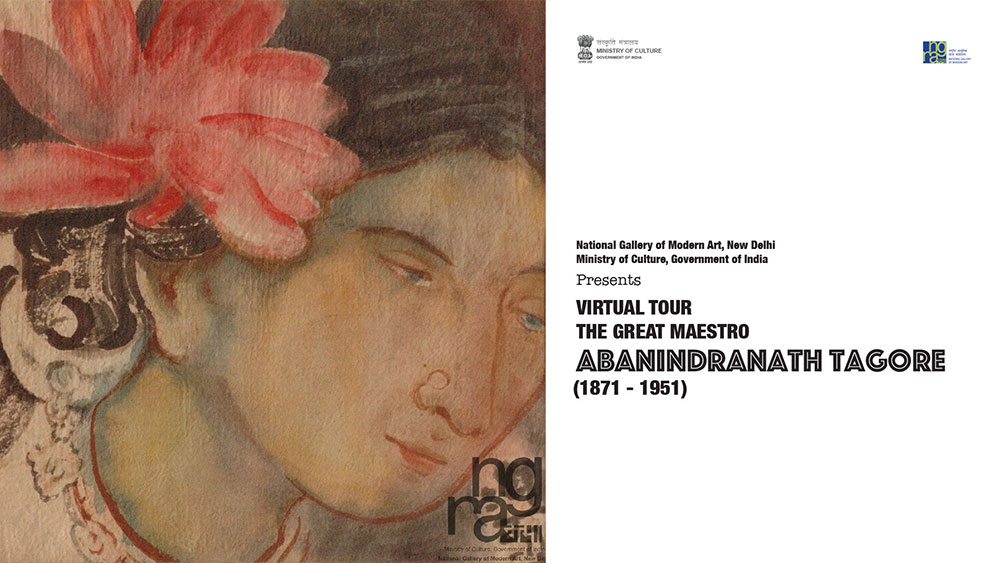
-
Painting
 ×Leader of the Revivalist Movement in the field of Modern Indian Painting in Bengal, Abanindranath Tagore is also credited with a key contribution towards ushering in the renaissance in Indian painting.Abanindranath's inner urge for liberating Indian art was further inspired by Okakura, a great Japanese artist and art-critic who came to India with Swami Vivekananda. His work has a great delicacy of feeling, unity of concept, a highly sensitive range of color, tone, texture and poetic depth. His work was a mixture of traditionalism and innovation. He aimed at comparing nature in its transient forms and produce an image part object, part sensuous, both transposed into each other.
×Leader of the Revivalist Movement in the field of Modern Indian Painting in Bengal, Abanindranath Tagore is also credited with a key contribution towards ushering in the renaissance in Indian painting.Abanindranath's inner urge for liberating Indian art was further inspired by Okakura, a great Japanese artist and art-critic who came to India with Swami Vivekananda. His work has a great delicacy of feeling, unity of concept, a highly sensitive range of color, tone, texture and poetic depth. His work was a mixture of traditionalism and innovation. He aimed at comparing nature in its transient forms and produce an image part object, part sensuous, both transposed into each other. -
Painting
 ×Between 1925 and 1930, according to artist Benodebehari Mukherjee who compiled a rough chronology of Abanindranath's paintings, the artist made a set of nine pastels of his impressions of the performance of the play.
×Between 1925 and 1930, according to artist Benodebehari Mukherjee who compiled a rough chronology of Abanindranath's paintings, the artist made a set of nine pastels of his impressions of the performance of the play. -
Painting
 ×Nurjehan (1577-1645) was the wife of Mughal emperor Jahangir and was said to have great influence over the Emperor. Abanindranath painted a series of female figures between 1920 and 1925. These included a portrait of Nurjehan. Art historian R. Siva Kumar has written that Abanindranath visualized the historical portraits after reading historical and literary texts of the period.
×Nurjehan (1577-1645) was the wife of Mughal emperor Jahangir and was said to have great influence over the Emperor. Abanindranath painted a series of female figures between 1920 and 1925. These included a portrait of Nurjehan. Art historian R. Siva Kumar has written that Abanindranath visualized the historical portraits after reading historical and literary texts of the period. -
Painting
 ×'Gurudev' is the epithet bestowed on Rabindranath Tagore by Mahatma Gandhi. Abanindranath had painted many portraits of his uncle Rabindranath, a number of which are in the NGMA Collection. In this image as in a couple of other, the artist places him against a vast and open landscape.
×'Gurudev' is the epithet bestowed on Rabindranath Tagore by Mahatma Gandhi. Abanindranath had painted many portraits of his uncle Rabindranath, a number of which are in the NGMA Collection. In this image as in a couple of other, the artist places him against a vast and open landscape. -
Painting
 ×The painting is a splendid evocation of the pensive mood of the twilight hours. The silhouetted figure on the left appears to be the standing figure of Rabindranath Tagore. The deepening shadows in the foreground contrasted with the glowing orange sky lit by the setting sun infuse the image with a sense of poetry.
×The painting is a splendid evocation of the pensive mood of the twilight hours. The silhouetted figure on the left appears to be the standing figure of Rabindranath Tagore. The deepening shadows in the foreground contrasted with the glowing orange sky lit by the setting sun infuse the image with a sense of poetry. -
Painting
 ×This is clearly a portrait of Rabindranath Tagore but Abanindranath's focus is not portraiture but evoking a mood through landscape, architectural elements and the nocturnal atmosphere.
×This is clearly a portrait of Rabindranath Tagore but Abanindranath's focus is not portraiture but evoking a mood through landscape, architectural elements and the nocturnal atmosphere. -
Painting

Tinkling Bells Acc. No. 1172 | Wash and tempera on paper
-
Painting
 ×The painting was probably done in the early 20's of the twentieth century following a visit to the mountains. The delicately rendered portrait conjures up an atmosphere which the artist may well have done from memory.
×The painting was probably done in the early 20's of the twentieth century following a visit to the mountains. The delicately rendered portrait conjures up an atmosphere which the artist may well have done from memory. -
Painting

Study of Face Acc. No. 1185 | Watercolour on paper
-
Painting
 ×The title 'Surangama' is written in vertical calligraphic style at bottom left side. Surangama is an important character in Rabindranath's play 'Raja'. The play was written around 1910-11 and was performed soon after on the family stage at Jorasanko, Kolkata. It is difficult to say whether the visualization related to the 1911 production or a later one. But it is clear that the staging of a play excited Rabindranath and the characters he visualized were not actual portraits but were creations of the artist's imagination.
×The title 'Surangama' is written in vertical calligraphic style at bottom left side. Surangama is an important character in Rabindranath's play 'Raja'. The play was written around 1910-11 and was performed soon after on the family stage at Jorasanko, Kolkata. It is difficult to say whether the visualization related to the 1911 production or a later one. But it is clear that the staging of a play excited Rabindranath and the characters he visualized were not actual portraits but were creations of the artist's imagination. -
Painting
 ×This painting by Abanindranath Tagore depicts an old standing in his veranda. The background reveals Mughal architecture. This has been rendered with the swift, fluid strokes of watercolour in tonal variation delineating the forms. In the '40s of the 20th century, Abanindranath gave expression to the playful, whimsical side of his imagination by making small sculptural objects like twigs, roots, branches and so on. The conceptualization of a walking figure was painted in the 40's preceding the figure. Art historian Ratan Parimoo calls it a weird figure.
×This painting by Abanindranath Tagore depicts an old standing in his veranda. The background reveals Mughal architecture. This has been rendered with the swift, fluid strokes of watercolour in tonal variation delineating the forms. In the '40s of the 20th century, Abanindranath gave expression to the playful, whimsical side of his imagination by making small sculptural objects like twigs, roots, branches and so on. The conceptualization of a walking figure was painted in the 40's preceding the figure. Art historian Ratan Parimoo calls it a weird figure. -
Painting

The Lost Child Acc. No. 1193 | Watercolour on paper
-
Painting
 ×This drawing appears to be of a character from Valmiki-Pratibha. The musical play by Rabindranath Tagore was first produced at the family mansion at Jorasanko in the early 1880's. These drawings may have been from a later production.
×This drawing appears to be of a character from Valmiki-Pratibha. The musical play by Rabindranath Tagore was first produced at the family mansion at Jorasanko in the early 1880's. These drawings may have been from a later production. -
Painting

Leaving for Home on Puja Vacation Acc. No. 1211 | Watercolour on paper
-
Painting

Her Grand Daughter's Toys Acc. No. 1645 | Watercolour, wash & Tempera on paper
-
Painting
 ×Beginning with series of illustrations for the Krishna Leela, Abanindranath painted many episodes from the Radha-Krishna stories. In this beautiful painting, Krishna is promising Radha lifelong subservience. R. Siva Kumar dates this painting to c. 1920's.
×Beginning with series of illustrations for the Krishna Leela, Abanindranath painted many episodes from the Radha-Krishna stories. In this beautiful painting, Krishna is promising Radha lifelong subservience. R. Siva Kumar dates this painting to c. 1920's. -
Painting
 ×From the style of flat treatment of space, bright colours and minimum of details, it appears that the painting could have been done between 1900-1910. The painting is an example of the phase when Abanindranath blended the European pre- Raphaelite style of drapery with the delicacy of traditional Indian miniatures.
×From the style of flat treatment of space, bright colours and minimum of details, it appears that the painting could have been done between 1900-1910. The painting is an example of the phase when Abanindranath blended the European pre- Raphaelite style of drapery with the delicacy of traditional Indian miniatures. -
Painting
 ×Art historian R. Siva Kumar places the painting c.1920. It is a visualization of the famous Mughal queen. Abanindranath had done several such paintings from imagination. In Siva Kumar's book, the painting is titled 'Taj Bibi'.The painting was acquired in the NGMA's collection in the year 1961 with title 'Momtaj', however the chronology of Abanindranath Tagore's paintings prepared by artist Benod Behari Mukherji published in Visva Bharti quarterly (May- October 1942) titles this painting as Taj Bibi - Lady with Hubble Bubble.
×Art historian R. Siva Kumar places the painting c.1920. It is a visualization of the famous Mughal queen. Abanindranath had done several such paintings from imagination. In Siva Kumar's book, the painting is titled 'Taj Bibi'.The painting was acquired in the NGMA's collection in the year 1961 with title 'Momtaj', however the chronology of Abanindranath Tagore's paintings prepared by artist Benod Behari Mukherji published in Visva Bharti quarterly (May- October 1942) titles this painting as Taj Bibi - Lady with Hubble Bubble. -
Painting
 ×This painting was done from memory after his mother's death. Scholar have dated it c.1912.
×This painting was done from memory after his mother's death. Scholar have dated it c.1912. -
Painting
 ×This gem of a painting with a fine jewel like finish paints the fine details with a magical appeal. With use of warm golden tones of yellow ochre and red, the miniature-like painting evokes a sense of peace. This painting may have been done during Abanindranath's sojourn to the Darjeeling hills between 1919 and 1920.
×This gem of a painting with a fine jewel like finish paints the fine details with a magical appeal. With use of warm golden tones of yellow ochre and red, the miniature-like painting evokes a sense of peace. This painting may have been done during Abanindranath's sojourn to the Darjeeling hills between 1919 and 1920.
